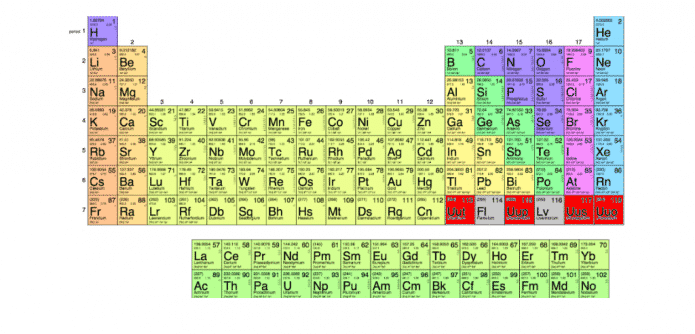Four elements have just earned a permanent spot in the periodic table to complete the seventh row
The officials from the International Union of Pure and Applied Chemistry (IUPAC) on December 30, 2015 announced the verification of the discoveries of the last four elements, 113, 115, 117, and 118 of the seventh period of the periodic table. Discovered by scientists from Japan, Russia and America, these elements are the first to be added to the table since 2011, when elements 114 and 116 were added.
IUPAC announced that a Russian-American team of scientists at the Joint Institute for Nuclear Research in Dubna and Lawrence Livermore National Laboratory in California had produced sufficient evidence to claim the discovery of elements 115, 117 and 118. The body awarded credit for the discovery of element 113, which had also been claimed by the Russians and Americans, to a team of scientists from the Riken Institute in Japan.
Kosuke Morita, who was leading the research at Riken, said his team now planned to “look to the unchartered territory of element 119 and beyond.”
Ryoji Noyori, former Riken president and Nobel laureate in chemistry said: “To scientists, this is of greater value than an Olympic gold medal”.
These four elements discovered cannot be found in the nature, since they are synthetic elements that can only be produced in the lab. Also, as they decay in a matter of seconds, their existence has been extremely difficult to confirm. Until now, elements 113, 115, 117, and 118 had temporary names and positions on the seventh row of the periodic table because scientists have struggled to create them more than once.
“For over seven years we continued to search for data conclusively identifying element 113, but we just never saw another event,” Kosuke Morita from RIKEN in Japan said of one of the four elements. “I was not prepared to give up, however, as I believed that one day, if we persevered, luck would fall upon us again.”
The elements, which currently bear placeholder names, will be officially named by the teams that discovered them in the coming months. Element 113 will be the first element to be named in Asia.
“The chemistry community is eager to see its most cherished table finally being completed down to the seventh row,” said Professor Jan Reedijk, president of the Inorganic Chemistry Division of IUPAC.
“IUPAC has now initiated the process of formalising names and symbols for these elements temporarily named as ununtrium, (Uut or element 113), ununpentium (Uup, element 115), ununseptium (Uus, element 117), and ununoctium (Uuo, element 118).”
It should be noted that Lawrence Livermore National Laboratories and the Joint Institute for Nuclear Research in Dubna each have their own element named after them: Lawrencium and Dubnium, with atomic numbers 103 and 105, respectively.
The organisation advises that the new elements can be named after a mythological concept, a mineral, a place or country, a property or a scientist, and will be presented for public review for five months before a final decision about the new official name and symbol is made.
Details of element 113’s discovery have been reported in the Journal of Physical Society of Japan. However, reports on the confirmation of elements 115, 117, and 118 have yet to be published.
The RIKEN researchers explain how in 2003, they began attacking a thin layer of bismuth with zinc ions going at about 10 percent the speed of light, and according to theory, the reaction should occasionally produce an atom of element 113.
The team saw signs of dubnium-262 (element 105) in 2004 and 2005, which is believed to be the decay product of element 113. However, this was not proof enough to prove its existence.
“[T]he group performed a new experiment, where a sodium beam was collided with a curium target, creating borhium-266 and its daughter nucleus, dubnium-262,” explains a press release. “With this demonstration, the grounds for a stronger claim were laid. They just needed to wait to see an atom decaying through the alpha chain rather than spontaneous fission.”
The team was able to accomplish this only in 2012. It took almost four years for the IUPAC to wade through the scientific literature and endorse that the evidence met their criteria for the discovery of elements.
“Now that we have conclusively demonstrated the existence of element 113,” says lead RIKEN researcher, Kosuke Morita, “we plan to look to the uncharted territory of element 119 and beyond, aiming to examine the chemical properties of the elements in the seventh and eighth rows of the periodic table, and someday to discover the Island of Stability.”
While reports on the confirmation of elements 115, 117, and 118 are yet to be published, details of element 113’s discovery have been reported in the Journal of Physical Society of Japan.

